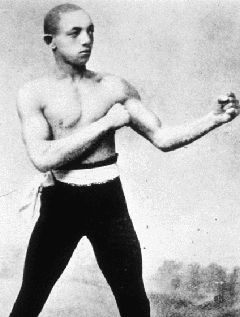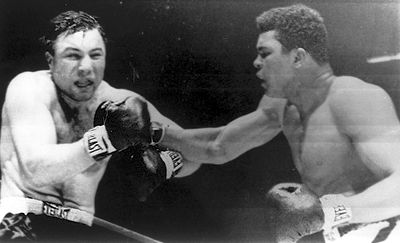Yvon Durelle (the Fighting Fisherman), boxer (born 14 October 1929 in Baie-Sainte-Anne, NB; died 6 January 2007 in Moncton, NB). Yvon Durelle was an Acadian boxer. A heavy-handed power puncher, Durelle was Canadian middleweight champion (1953) and light heavyweight champion (1953–57); as well as British Empire light heavyweight champion (1957). In 1958, he earned international fame for a legendary 11-round slugfest against defending world champion Archie Moore at the Forum in Montreal. Durelle had a career record of 88 wins (49 by knockout), 24 losses and two draws. He was inducted into Canada’s Sports Hall of Fame, the New Brunswick Sports Hall of Fame, the Maritime Sports Hall of Fame and the Canadian Boxing Hall of Fame. He died at 77 following a years-long battle with Parkinson’s disease.
Early Life and Career
Yvon Durelle was born in the Acadian seaside village of Baie-Sainte-Anne, New Brunswick. Fighting was part of the fabric of the Durelle family. As a child, Yvon participated in neighbourhood brawls staged by his father, Ernest, much to the dismay of his mother, Alida. One of 14 children, Durelle left school as a child to work on fishing boats; he claimed to have captained his first ship at age 11. He followed in the footsteps of his older brother, Ernie, who was also a local professional boxer.
Durelle began fighting professionally at the age of 14. He was gifted with natural ability, including heavy hands and one-punch knockout power. He once boasted that his uppercut could “knock a man’s head off.”
Canadian Middleweight Champion
The five-foot-nine Durelle began boxing professionally across New Brunswick when he was either 17 or 18. His first fight took place in Chatham, where he earned $8 after registering a knockout victory.
Durelle rose up the middleweight rankings. He competed for the Canadian middleweight championship on 2 May 1953 at the Glace Bay Forum in Glace Bay, Nova Scotia. He defeated his opponent, George Ross, via technical knockout.
Canadian Light Heavyweight Champion
Following seven consecutive victories as the middleweight champ, Durelle moved up in weight class to compete against Gordon Wallace for the vacant Canadian light heavyweight title on 7 September 1953. Durelle won via unanimous decision. He successfully defended the belt in a rematch just over one month later.
On 15 February 1954, Durelle competed in his first bout outside of Canada. He squared off against 19-year-old Floyd Patterson in Brooklyn, New York. Patterson, an Olympic gold medalist, Golden Gloves winner and soon to be heavyweight champion, defeated Durelle to extend his professional record to 10–0. Durelle lasted the full eight rounds against the six-foot-tall Patterson and nearly knocked him to the mat in the final round. This only boosted Durelle’s reputation as a brave, tough fighter.
British Empire Light Heavyweight Champion
In the years that followed, Durelle continued to climb up the rankings. A 10-round decision over Angelo DeFendis in New York City on 22 April 1957 helped him break into the Top 10 of the world light heavyweight rankings. One month later, in Moncton, New Brunswick, Durelle won the British Empire (Commonwealth) light heavyweight championship.
On 14 June 1957, he competed against top-ranked contender Tony Anthony at Olympia Stadium in Detroit, Michigan. The two fought to a draw, but the performance earned Durelle the No. 3 spot in the worldwide rankings. A win over West German champion Willi Besmanoff, along with a TKO victory against gifted light heavyweight Clarence Hinnant at Madison Square Garden in 1958, helped secure Durelle’s first shot at the world title.
First Bout vs. Archie Moore
On 10 December 1958 at the Forum in Montreal, the 29-year-old Durelle squared off against 44-year-old world light heavyweight champion Archie Moore of the United States. Despite the age difference, Durelle entered the bout a 3:1 underdog against the iron-jawed and highly strategic Moore, whom many consider the best light heavyweight ever. As a local scribe from the Montreal Gazette wrote at the time, “People snicker when the name Yvon Durelle is placed alongside that of Archie Moore.”
Durelle did not wait long to disprove his doubters. A stunned crowd of more than 8,000 people — along with a national television audience in the United States — watched as Durelle’s thundering overhead right knocked Moore to the canvas at the outset of the match; one of three first-round knockdowns delivered by Durelle. “The first time he put me down,” Moore recalled in a 1989 Sports Illustrated profile, “I hit my head first, then my feet. I was laying there and I thought, ‘Wow, this guy can hit!’ They said [Rocky] Marciano was a house-wrecker, and he was, but it took him a volley to get the job done. This guy: one punch.”
In the fifth round, Durelle pounded Moore into the canvas once more, but the champion responded in the sixth, bloodying Durelle’s nose before knocking him to the mat in round seven. “In the tenth, the bell began to toll for Durelle’s Cinderella story,” wrote iconic boxing reporter Bert Sugar. Durelle’s strikes began to miss wildly as fatigue set in and the veteran Moore took control, knocking out the Canadian challenger in round eleven. Despite the loss, Durelle’s performance won over boxing fans across the continent. The Canadian Press named the match the Sporting Event of the Year.
Escuminac Disaster
Roughly six months later, on 19–20 June 1959, 35 fishermen in Durelle’s hometown of Baie-Sainte-Anne died after being swept to sea by tidal waves that reached as high as 49 feet. The tragedy, which came to be called the Escuminac Disaster, is one of the deadliest events on record in New Brunswick fisheries. (See Marine Disasters.) Durelle lost many friends and acquaintances and his community was devastated.
Second Bout vs. Archie Moore
On 12 August 1959, Durelle and Moore met again at the Montreal Forum for a much-anticipated rematch. But prior to the fight, Durelle injured his back in a boating accident. He lasted just three rounds before losing via TKO. It was also reported that the Escuminac Disaster had taken such an emotional toll on Durelle that he did not adequately train for the fight.
That November, Durelle took on George Chuvalo at Maple Leaf Gardens in Toronto for the Canadian heavyweight title; he lost by knockout in the 12th round. After two more fights the following year, Durelle hung up his gloves until 1963, when he fought three more matches before officially retiring from the sport. He posted a career record of 88 wins (49 KOs), 24 losses and two draws.
Post-Boxing Life and Career
Immediately following his boxing career, Durelle took part in professional wrestling matches, both at home in Atlantic Canada and for Stu Hart’s popular Stampede Wrestling in Calgary, Alberta.
Durelle settled in Baie-Sainte-Anne with his long-time wife, Thérèse, whom he married in 1951. Although he earned a decent living during parts of his career (including a reported $26,000 for the first Moore bout and $60,000 for the second), he struggled financially after his retirement. He worked in the forestry industry until 1974, when he managed to secure a loan to open a bar, the Fisherman’s Club, in Baie-Sainte-Anne.
One night at the club in April 1977, Durelle shot and killed a 32-year-old patron in the parking lot. He claimed the man had been threatening him and his family and tried to run over Durelle with his car. A jury acquitted Durelle of a charge of non-capital murder. Durelle sold the bar the following spring.
Durelle died in a Moncton hospital on 6 January 2007 at the age of 77 after battling Parkinson’s disease for several years.
Honours and Awards
- New Brunswick Sports Hall of Fame (1971)
- Canada’s Sports Hall of Fame (1975)
- Canadian Boxing Hall of Fame (1989)
- Maritime Sports Hall of Fame (2015)

 Share on Facebook
Share on Facebook Share on X
Share on X Share by Email
Share by Email Share on Google Classroom
Share on Google Classroom



